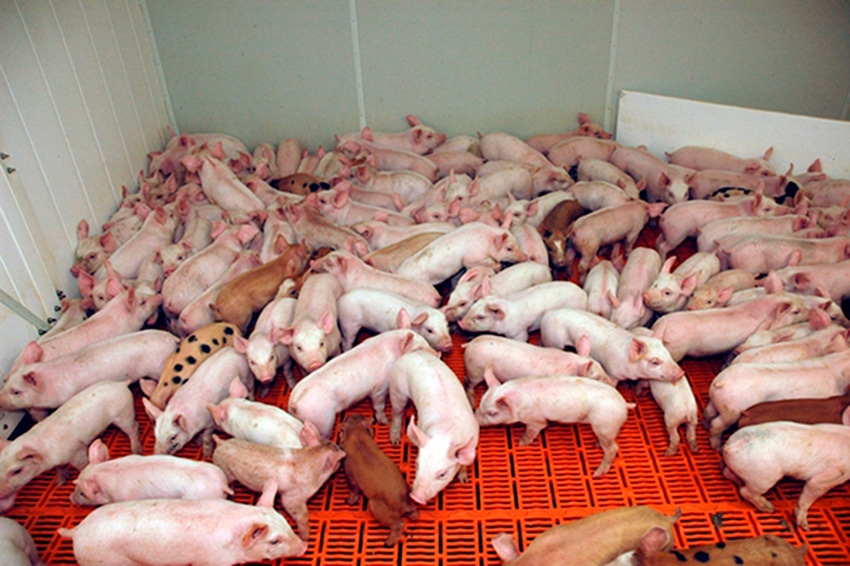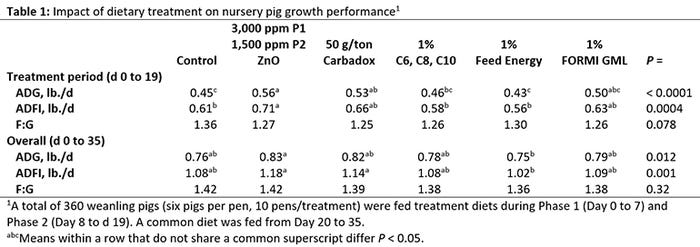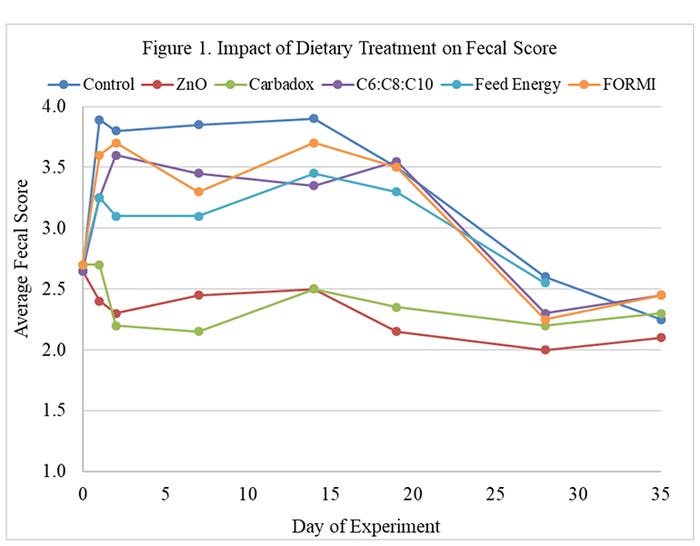Our objective was to evaluate three different MCFA combinations in place of ZnO and carbadox on nursery pig growth performance.
July 11, 2019

By Payton Dahmer, Grace Luebcke, Annie Lerner and Cassandra Jones, Kansas State University
Antimicrobial agents, such as zinc and carbadox have been utilized for decades to improve nursery pig health and growth performance by preventing and controlling diseases. Despite their benefits, there is increasing environmental and consumer pressure to reduce their use. This leaves swine producers on a search for antimicrobial replacements that can yield the same positive outcomes, while avoiding any negative consequences.
Medium chain fatty acids have been demonstrated to reduce the risk of viruses in swine feed, and Cochrane et al. (2018) described their ability to replace 400 grams per ton chloretetracyline in Phase 2 nursery diets. Controlled research has reported increased growth performance when MCFA are fed in mid- to late-nursery diets, even in the absence of health challenges (Thomson et al., 2018, Thomas et al., 2019). However, field research has reported mixed results, especially when feeding begins in early nursery.
Our objective was to evaluate three different MCFA combinations in place of ZnO and carbadox on nursery pig growth performance. A total of 360 weaned pigs (DNA 200 x 400; 5.4 ± 0.07 kilograms body weight; approximately 21 days of age) were used in a 35-day experiment at the Kansas State University Swine Teaching and Research Center. Upon weaning, pigs were individually weighed and allotted to pens based on body weight to one of six dietary treatments: 1) Negative control (no added ZnO or carbadox); 2) Control plus 3,000 parts per million ZnO in Phase 1 and 2,000 ppm ZnO in Phase 2; 3) Control plus 50 grams per ton carbadox; 4) Control plus 1% blend of C6:0, C8:0 and C10:0 in a 1:1:1 blend (PMI Nutritional Products) 5) Control plus Feed Energy vegetable oil blend (Feed Energy Corp.); 6) Control plus 1% FORMI GML (ADDCON). Diets were isocaloric, with choice white grease used to balance the energy level.
Dietary treatments were fed for Phase 1 and 2, with a common Phase 3 fed from Day 19 to 35 post-weaning. Fecal scores were collected initially after weaning and weekly thereafter using a numerical scale from 1 to 5, with 1 being hard pellet-like feces and 5 being a watery liquid stool.
During the treatment period (Day 0 to 19), pigs fed the ZnO or carbadox diets had the greatest average daily gain (Table 1). These pigs had significantly greater (P < 0.05) ADG than pigs fed the control or Feed Energy vegetable oil blend, with pigs fed the FORMI GML diet being intermediate. These effects were mostly driven by feed intake, which was greatest (P < 0.05) in pigs fed diets containing ZnO or carbadox, and lowest in pigs fed diets containing the 1% C6:C8:C10 or Feed Energy blends, with pigs fed the FORMI GML diets again being intermediate. Dietary treatment had a marginally significant effect (P > 0.078) on F:G, with the poorest feed efficiency belonging to pigs fed the control. These effects carried over for the overall nursery period, even after a common Phase 3 diet.

Fecal scores are depicted in Figure 1. Pigs fed diets containing either ZnO or carbadox had firmer (P < 0.05) feces than those fed all other treatments on Day 1, 2, 7, 14 and 19. However, upon transitioning pigs to the Phase 3 common diet, fecal scores became more consistent across dietary treatment.

These results reinforce that ZnO and carbadox are valuable additives to maximize growth in early nursery pig diets. Some MCFA products, such as FORMI GML, may provide statistically similar growth performance, but with softer stools. Other MCFA products may actually reduce feed intake, and therefore ADG, during the early nursery period.
Sources: Payton Dahmer, Grace Luebcke, Annie Lerner and Cassandra Jones, Kansas State University, who are solely responsible for the information provided, and wholly own the information. Informa Business Media and all its subsidiaries are not responsible for any of the content contained in this information asset.
You May Also Like


